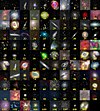NGC 457

|
|
| NGC 457 , the owl cluster or ET cluster | |
| AladinLite | |
| Constellation | Cassiopeia |
|
Position equinox : J2000.0 |
|
|---|---|
| Right ascension | 01 h 19 m 32.6 s |
| declination | + 58 ° 17 ′ 27 ″ |
| Appearance
|
|
| classification | I3r |
| Brightness (visual) | 6.4 mag |
| Brightness (B-band) | 6.97 likes |
| Angular expansion | 20 ' |
| Number of stars | about 80 |
| Brightest star | 8.6 likes |
| Redness ( excess color E (BV)) | 0.472 mag |
| Physical data
|
|
| Affiliation | Arm of Perseus , Milky Way |
| Redshift | (-105 ± 10) · 10 −6 |
| Radial velocity | (-31.61 ± 3.12) km / s |
| distance | approx. 9000 ly |
| diameter | approx. 30 ly |
| Age | about 20 million years |
| history | |
| Discovered by | Wilhelm Herschel |
| Discovery time | October 18, 1787 |
| Catalog names | |
| NGC 457 • C 0115 + 580 • OCl 321 • Mel 7 • Cr 12 • Lund 43 • GC 256 • Raab 3 • H VII 42 • h 97 | |
NGC 457 is an open star cluster in the constellation Cassiopeia in the northern sky . It is 13 'in diameter and has an apparent magnitude of +6.4 mag. This makes the cluster one of the brightest star clusters in the constellation Cassiopeia and one of the brightest open star clusters not listed in the Messier catalog . Because of its appearance, the star cluster is also nicknamed the Owl Cluster or ET Cluster .
The brightest and dominant star is Phi Cassiopeiae , which is why the cluster is sometimes referred to as the Phi Cassiopeiae cluster . Together with Phi Cassiopeiae, HD 7902 stands out clearly and the two stars together form the "eyes" of the cluster. However, both Phi Cassiopeiae and HD 790 2 are likely to be foreground stars and not actual members of the star cluster. NGC 457 lies in the Perseus arm of the Milky Way , about 9,000 light years from the solar system; the extent of the star cluster is estimated to be around 30 light years and its age around 20 million years.
The object was discovered by Wilhelm Herschel on October 18, 1787 .
Web links
- Deep-Sky Corner
- WEBDA
- Spektrum.de : Collection of amateur recordings
